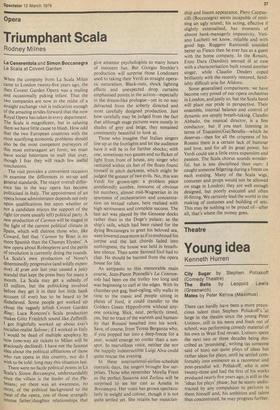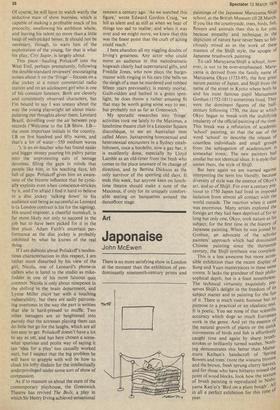Theatre
Young idea
Kenneth Hurren
City Sugar by Stephen Poliakoff (Comedy Theatre) The Bells by Leopold Lewis (Greenwich) Mates by Peter Kenna (Maximus) There can hardly have been a more precocious talent than Stephen Poliakoff's at large in the theatre since the young Peter Ustinov, still in his teens and fresh out of school, was performing comedy material of his own in West End revues. Ustinov spent the next two or three decades being described as 'promising', writing (as someone said of him) not quite plays of ideas but rather ideas for plays, until he settled comfortably into eminence as a raconteur and post-prandial wit. Poliakoff, who is now twenty-three and had the first of his works produced nearly five years ago, is still in the 'ideas for plays' phase; but he seems undistracted by any compulsion to perform in them himself and, his ambition and talent thus concentrated, he may progress further. Of course, he will have to watch warily the seductive maw of show business, which is capable of making a profitable snack of his precocity, swallowing his ambition whole, and leaving his talent no more than a little heap of well-picked bones. It should not be necessary, though, to warn him of the exploitation of the young, for that is what his play, City Sugar, is largely about.
This piece--hauling Poliakoff into the West End, perhaps prematurely, following the double-standard reviewers' encouraging noises about it on the 'fringe'—focuses on a disc jockey at a minor commercial radio station and on an adolescent girl who is one of his constant listeners. Both are cleverly and consistently observed characters, but I'm bound to say I was uneasy about the way the young playwright set about manipulating our thoughts about them. Leonard Brazil, drivelling over the air between pop records (Welcome to the LB Show. LB— the most important initials in the country. LB on five hundred and fifty waves, and that's a lot of water-550 medium waves ...'), is an ex-teacher who has found easier and bigger money pouring his paltry patter into the unprotesting ears of teenage devotees, filling the gaps in minds that people like him, in his teaching days, left full of gaps. Poliakoff gives him an awareness of the bizarre influence that he cynically exploits even when conscience-stricken by it, and I'm afraid I find it hard to believe in a disc jockey 'talking down' to his audience and being as successful as Leonard is (a London contract is his for the signing). His sound engineer, a cheerful numskull, is far more likely not only to succeed in the job but to have been picked for it in the first place. Adam Faith's uncertain performance as the disc jockey is probably inhibited by what he knows of the real thing.
If I am dubious about Poliakoff's tendentious characterisation in this respect, I am rather more disturbed by his view of the girl, Nicola, one of Leonard's phone-in callers who is lured to the studio as mikefodder in one of his more fatuous quiz contests. Nicola is only about ninepence in the shilling in the brain department, and Lynne Miller plays her with a touching vulnerability, but there are sadly patronising overtones in the way the part is written that she is hard-pressed to muffle. Two other teenagers are so heightened into parody that the actresses playing them can do little but go for the laughs, which are all too easy to get. Poliakoff doesn't have a lot to say as yet, and has here chosen a somewhat spurious and prolix way of saying it (an 'idea for a play' too casually worked out), but I suspect that the big problem he will have to grapple with will be how to cloak his lofty disdain for the intellectually underprivileged under some sort of show of compassion.
As if to reassure us about the state of the contemporary playhouse, the Greenwich Theatre has revived The Beds, a play in which Sir Henry Irving achieved sensational renown a century ago. 'As we watched this figure,' wrote Edward Gordon Craig, 'we fell as silent and as still as when we hear of things too sad to realise; and when it was over and we might move, we knew that this was the finest point that the craft of acting could reach.'
I here abandon all my niggling doubts of Irving's greatness. Any actor who could move an audience in this melodramatic hogwash clearly had supernatural gifts, and Freddie Jones, who now plays the burgomaster with ringing in his ears (the bells on the sleigh of a man he murdered and robbed fifteen years previously), is merely mortal. Guilt-ridden and bathed in a green spotlight, he does throw a rather amusing fit that may be worth going some way to see; but probably not as far as Greenwich.
My sporadic researches into 'fringe' activities took me lately to the Maximus, a lunchtime theatre club in a Leicester Square discotheque, to see an Australian item called Mates. Juxtaposing homosexual and heterosexual encounters in a Sydney establishment, once a bordello, now a gay bar, it is excellently done, especially by Lloyd Lamble as an old-timer from the bush who comes to the place unaware of its change of direction, and by Bettina Dickson as the only survivor of the sporting old days. It ends this week, but anyone keen on lunchtime theatre should make a note of the Maximus, if only for its uniquely comfortable seating on banquettes around the dancefloor stage.
paintings of the Japanese MaruyamalShija school, at the British Museum till 28 March. If you like the countryside, trees, birds, fish, flowers and animals then this is for you, because empathy and technique in the depiction of nature have never been so felicitously mixed as in the work of these masters of the Shirostyle, the apogee of Japanese brushwork painting.
To call Maruyama/Shijo a school, how ever, is not to be over-emphasised. Marvyama is derived from the family name of Maruyama Okyo (1733-95), the first great nature painter of Japan, and Shijo from the name of the street in Kyoto where both he and his most famous pupil Matsumura Goshun (1752-1811) sometimes lived. They were the dominant figures of the half century following 1750, the date at which Okyo began to break with the stultifying insularity of the official painting of the time This break was a refutation of academic 'school' painting, so that the use of the word 'school' to describe the release of countless individuals and small groups from the subjugation of academicism is somewhat ironic. The new painters had similar but not identical ideas. It is style that unites them, the style of
But here again we are warned against interpreting the term too literally, because diversity of style was the essence of Okyo s art, and so of Shija. For over a century Previous to 1750 Japan had lived in imposed isolation from almost all contact with the world outside. The reaction when it came was enormous. Many artists explored the foreign art they had been deprived of for so long but only one, Okyo, took nature as his subject, for the first time in the history of Japanese painting. When he was joined bY Goshun, an advocate of the scholar painters' approach which had dominated Chinese painting since the thirteenth century, the ShiFi synthesis was complete.
This is a less awesome but more accessible exhibition than the recent display Of Sung and Yuan masterpieces in these same rooms. It lacks the grandeur of their philosophical depth, but is a feast nonetheless. The technical virtuosity exquisitely preserves Shifo's delight in the freedom of its subject matter and in painting for the fun of it. There is much rustic humour but no purpose to a practical or an idealistic end. It is poetic. You see none of that scientific accuracy which dogs so much European work in the genre. And yet the essence. °f the natural growth of plants or the Quick movements of birds and fish is effortlesslY caught time and again by sharp brushstrokes or brilliantly turned washes. Nothing demonstrates this better than Matsumura Keibun's handscroll of 'Spring flowers and trees' (note the wistaria blooms and the brown, fresh sprung cherry leaves), and for those who have hitherto missed the point of wood blocks, look how the texture. of brush painting is reproduced in Nish!: yama Kan'ei's 'Bird on a plum bough'. A1,1 in all a perfect exhibition for this time of year.



































 Previous page
Previous page